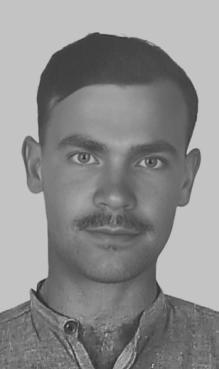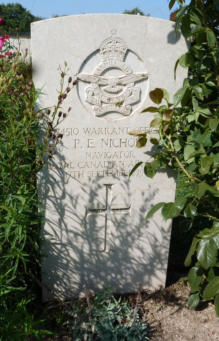
copyright © Wartime Heritage Association
Website hosting courtesy of Register.com - a web.com company
Wartime Heritage
ASSOCIATION
Remembering World War II
Name:
Paul Eaton Nichols
Rank:
Warrant Officer Class II
Service Number:
R/124510
Service:
40 Squadron, Royal Canadian Air Force
Date of Birth:
March 29, 1918
Place of Birth:
Freeport, Digby Co., Nova Scotia
Date of Enlistment:
August 7, 1941
Place of Enlistment:
Halifax, Nova Scotia
Address at Enlistment:
Halifax, Nova Scotia
Age at Enlistment:
23
Height:
5 feet, 8 inches
Complexion:
Dark
Eye Colour:
Blue
Hair Colour:
Dark brown
Occupation:
Teacher
Marital Status:
Single
Religion:
Baptist
Next of Kin:
Herman S Nichols (Father)
Date of Death:
September 17, 1943
Age:
25
Cemetery:
Bolsena War Cemetery, Italy
Grave:
Section IV, Row A, Grave 3
Commemorated on Page 198 of the Second World War Book of Remembrance
Displayed in the Memorial Chamber of the Peace Tower in Ottawa on April 22
Paul Eaton Nichols was the son of Herman Spurgeon Nichols (1884-1971) and Jesse Manning (Brooks)
Nichols (1882-1956), and the brother of Raleigh Bishop Nichols (1914-2003), Theresa Augusta Nichols
(1916-2004), and Winston Lee Nichols (1923-2007).
Paul’s father was born in Carleton, Yarmouth Co., Nova Scotia, and his mother was born in Freeport on
Digby Neck.
Paul played hockey, attended public school and high school in Freeport, college from 1937-38 and
technical college from 1939-40 (history and English). From 1938-1941 he was employed as a teacher at
Central Grove in Digby County and Jordan Branch in Shelburne County.
After enlisting in August of 1941, Paul was posted to the No. 1 Service Flying Training School (1 SFTS) at
Camp Borden on August 22, 1941 and trained there until October 10 when he transferred to the No. 5
Initial Training School (5 ITS) in Belleville, Ontario. He subsequently transferred to No. 5 Air Observer
School (5 AOS) in Winnipeg, Manitoba on December 20, 1941, and the No. 7 Bombing and Gunnery
School in Paulson, Manitoba on March 29, 1942. On May 9, 1942, he transferred to No. 1 Air Navigation
School (1 ANS) in Rivers, Manitoba, completing his posting there on June 9, 1942 and then transferring
to Halifax, Nova Scotia prior to shipping overseas to the United Kingdom.
He embarked in Canada on July 20, 1942, arriving in the United Kingdom on July 30th. He joined
Operational Training Unit (OTU) No. 51 on September 1, 1942, and 12 OTU on October 17, 1942. Next,
he was assigned to Operational Training Unit (OTU) No. 15 on March 3, 1943, and departed the UK for
the Mediterranean Theatre on March 19, 1943.
From November 1942 to January 1943, 40 Squadron's aircraft were deployed to Malta, with the role of
disrupting Axis supply routes to North Africa during the Anglo-American invasion of French North-West
Africa. Paul joined the Squadron in March, and since of February 1943, the squadron was based at
‘Gardabia’ Airfield, Tunisia.
While based there the squadron replaced its worn-out Wellington Mk IC aircraft with newer and more
capable Wellington Mk IIIs. On February 18, 1943, 40 Squadron, together with most of the rest of the
RAF's night bomber force in the Mediterranean and American day bombers, joined the newly
established Northwest African Strategic Air Force. While designated as a Strategic force, the distance to
strategic targets from the airfields in North Africa meant that they were at first mainly employed on
tactical operations. The squadron flew operations against targets in Sicily during the Allied invasion of
that island in July–August 1943.
On September 17, 1943, Paul was serving as the Navigator Bomb Aimer aboard Vickers Wellington X
HF534 ‘D’ with Warrant Officer 1st Class Bruce Martin Berven, DFM, RCAF, Pilot (Service No. R/106299),
Warrant Officer 2nd Class Harry Allen Pennell, RCAF, Pilot (Service No. R/88737), Flight Sergeant James
Hawkyard, RAFVR (Service No. 1141090), and Flight Sergeant Walter George Webster, RAF (Service No.
1319063).
40 Squadron conducted raids on the enemy airfield at Cerveteri on in mid-September of 1943. The
attack on Cerveteri on September 17, 1943, including Wellington HF534 didn’t go well; with flares
scattered and illumination hampered by smoke, most of the bombing was concentrated north of the
target To add to a night of misfortune, one of the illuminators, (W/O B. M. Berven RCAF) caught fire
shortly after leaving the target area, and crashed off shore. The 205 Group report on the raid
speculates that this might have been caused by a hung-up flare, other records indicate the aircraft was
shot down (hit by enemy fire).
All five crew of HF534 were killed in action when their aircraft was seen to burst into flames and then
crash four miles off the coast near Cerveteri, north of Rome, Italy.
Warrant Officer Paul Eaton Nichols is interred at the Bolsena War
Cemetery, Italy. Paul is the only known WWII casualty with ties to
Nova Scotia interred at Bolsena.
The other four casualties (two RCAF, two RAF) of the aircraft
have no known graves and are remembered on the Malta War
Memorial in Malta.
Paul Eaton Nichols






- World War I - Menu
- WWI Stories and Articles
- Photos - Yarmouth Soldiers
- Selection of World War I Songs
- WWI Casualties of Yarmouth, NS
- Those Who Served - Yarmouth, NS
- WWI Casualties Digby Co. NS
- WWI Casualties Shelburne Co. NS
- Merchant Mariners (1915) Yarmouth, NS
- Canadian Forestry Corps - Non Yarmouth Birth/Residence Enlistments
- US Draft Registry - Yarmouth NS Born


- World War II - Menu
- WWII Stories and Articles
- Telegraphist Air Gunners
- WWII Casualties of Nova Scotia
- US Casualties with NS Connection
- Far East/Pacific Casualties with NS Connection
- Merchant Navy Casualties Nova Scotia
- Nova Scotia WWII Casualties Holten Canadian War Cemetery
- D-Day Casualties - Nova Scotia
- CANLOAN Program Casualties - Nova Scotia
- Battle of the Bulge Casualties - Nova Scotia
- WWII Casualties Yarmouth NS
- Yarmouth Casualties - RCAF RAF Canadian Army WWII
- Yarmouth Co., Marriages WWII
- Casualties Non-Born/Residents with Connection to Yarmouth Co., Nova Scotia.
- WWII Casualties Digby Co., NS
- Non-Nova Scotian WWII Casualties Buried in Nova Scotia
- WWII RCAF Casualties Aged 16-18
- Brothers/Sisters Who Served - World War II













